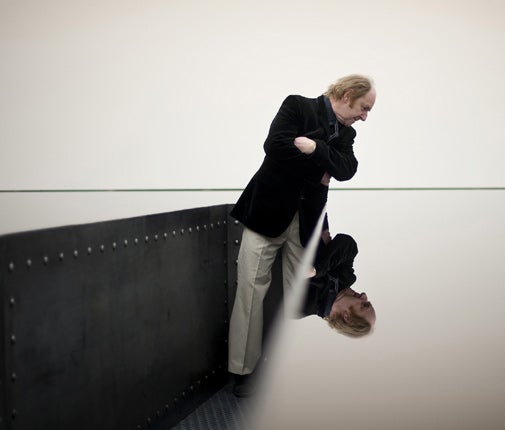20:50 Richard Wilson, Saatchi Gallery, London
Another fine and sumptuous mess

There is nothing new under the sun. The old things keep on returning, again and again.
And so it is over at the Saatchi Gallery this week. Richard Wilson's newly re-installed, room-saturating installation, 20:50, was first exhibited at the Saatchi Gallery in north London in 1987. This was Saatchi's first big public art space and it was wonderfully unusual for its time, like a strange, white-all-over aircraft hangar. Then the installation re-appeared when Saatchi made the unwise decision to occupy those grand(ish) rooms over at County Hall. It didn't look so good there because the small room it occupied, which peeled off from one of those drearily long, terminally bureaucratic corridors, felt too small, too pent and a bit too dingy. The space lacked light, size, panache – and that's what 20:50 needs. Now it's back in a space which resembles the one it occupied in north London. Is it worth seeing again, though?
Yes. In fact, looking at it – experiencing its meaning by standing in the middle of it – makes us understand why so many installations are so unsuccessful. Too obvious. Too fussy. Too noisy in their wish to grab our attention. Too unclear in their purpose. This one scores high on all four counts.
What Wilson has done is very simple. He has found something out about the quality and the nature of crude sump oil, the stuff you fill your car with. Sump oil is both dense and highly reflective.
Let me tell you what happens. You enter the room and walk towards the installation. You're on a walkway, above it, and when you reach a waist-height glass barrier, you lean over to look down at what's happening beneath you, because the floor seems to be a long way down – 20 or so feet, perhaps. Off to the left, you see that a flight of concrete steps descends to a kind of narrow aluminum bridge – the way its sides splay out makes you think of a funnel – that will take you almost into the middle of the room, suspended above everything. The bottom of the room seems like an exact copy of the ceiling, except that its colour is slightly different. The strange thing is – and this is almost the weirdest thing of all – that the bridge seems to have no visible sides...
At this point I ask an attendant whether I can go down the steps and on to that bridge – there is a rope across to prevent me. To my amazement, this request is a very serious matter. I have to sign a disclaimer, which exonerates Saatchi and Co if anything goes wrong. The serious-faced attendant tells me to keep my arms by my sides and not to let my pesky glasses swing loose. She even advises me to remove my glasses but when I mention near blindness, she relents.
I walk down the steps. I walk on to the bridge, which narrows as it goes along. Then I crouch down and solve the mystery. The sump oil rises as high as the edge of the handrail. I could touch it. I could get messy all over. What is more, it is not even deep (I discover that later, after interrogating the attendant.) It's just inches deep. But it is perfectly reflective of the ceiling, walls and windows that overlook it, marvelling, and it gives an illusion of great depth – so that the ceiling looks as if it is way beneath us. What is more, it is so dense – unlike water, which shudders with apprehension almost as you approach it – that it stays very, very still indeed, so that it is not immediately obvious that reflections are not realities.
Alice in Wonderland, that eager mirror-stepper, would have loved this. She would have needed to mind her pretty clothes, though.
Subscribe to Independent Premium to bookmark this article
Want to bookmark your favourite articles and stories to read or reference later? Start your Independent Premium subscription today.

Join our commenting forum
Join thought-provoking conversations, follow other Independent readers and see their replies